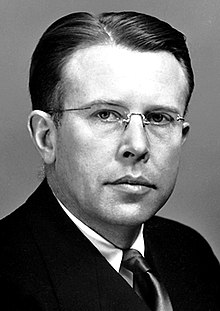Ernesto Lawrence
Ernest Orlando Lawrence (born August 8, 1901 in Canton , South Dakota ; died August 27, 1958 in Palo Alto , California ) was an American nuclear physicist and Nobel laureate .
Life
Ernest Lawrence was born on August 8, 1901 in Canton to Norwegians Carl Gustavus Lawrence and Gunda Regina Jacobson. After attending Canton High School and St. Olaf College , he began studying chemistry at the University of South Dakota in 1919, graduating with a BA in 1922. After an MA from the University of Minnesota in 1923, he went to the University of Chicago for a year , where he studied physics , and received his doctorate in physics from Yale University in 1925 . After three more years at Yale, two asNational Research Fellow and latterly as Assistant Professor of Physics, he was appointed Associate Professor of Physics at the University of California, Berkeley in 1928, which was converted to a full professorship in 1930. In 1936 he became director of the radiation laboratory.
Lawrence married Mary Kimberly Blumer, daughter of the Dean Emeritus of Yale Medical School , in May 1932 and had six children. He died in Palo Alto on August 27, 1958.
plant

After initial work on the ionization potential of metal vapors, Lawrence invented the cyclotron in 1929 , which he used to bombard various elements with accelerated particles. The particle bombardment has, on rare occasions, produced entirely new elements as well as hundreds of previously unknown radioactive isotopes of known elements. He applied for US patent protection for his invention on January 26, 1932 , which was granted to him on February 20, 1934. With a more powerful cyclotron, he was able to produce the mesons known from cosmic rays for the first time in 1941 , and later he extended his studies to include antiparticles .
Along with his brother , John H. Lawrence , who became director of the university's Laboratory for Medical Physics, he also explored the medical and biological applications of the cyclotron and became an advisor to the Institute for Cancer Research at Columbia.
Lawrence was instrumental in the development of the atomic bomb during World War II , after the war he campaigned for a ban on nuclear testing and was a member of the US delegation to the 1958 Geneva conference that discussed the issue.
Recognition and Awards
Lawrence was elected to the National Academy of Sciences in 1934 and to the American Academy of Arts and Sciences in 1937. From 1942 he was an honorary member of the USSR Academy of Sciences and from 1946 an Honorary Fellow of the Royal Society of Edinburgh .
He was awarded the Nobel Prize in Physics in 1939 for the invention and further development of the cyclotron and for the results achieved with it, in particular the production of artificial radioactive elements . The 103rd element of the chemical periodic table, lawrencium (Lr), was named after him.
- Elliott Cresson Medal , Franklin Institute
- Comstock Prize in Physics , 1938
- Hughes Medal , Royal Society
- Duddell Medal , Royal Physical Society
- Faraday Medal , Institution of Electrical Engineers
- Enrico Fermi Prize
- Medal for Merit
- Nobel Prize in Physics , 1939
- Officer of the Legion of Honour
- 14 honorary doctorates, 13 American and one British (Glasgow)
The lunar crater Lawrence is named after him and the astronaut Robert Henry Lawrence Jr. The biennial Ernest Orlando Lawrence Prize , awarded by the Atomic Energy Commission , is dedicated to him.
The Lawrence Livermore National Laboratory and the Ernest Orlando Lawrence Berkeley National Laboratory are named after him.
literature
- Luis Walter Alvarez : Ernest Orlando Lawrence, Biographical Memoirs National Academy of Sciences, 1970, pdf
- Herbert Childs, An American Genius: The Life of Ernest Orlando Lawrence, Father of the Cyclotron , New York: Dutton 1968
- John L. Heilbron : Lawrence and his Laboratory: A History of the Lawrence Berkeley Laboratory , University of California Press 1989
- Gregg Herken : Brotherhood of the Bomb: The Tangled Lives and Loyalties of Robert Oppenheimer, Ernest Lawrence, and Edward Teller , Henry Holt and Co. 2002
- Michael Hiltzik: Big Science: Ernest Lawrence and the Invention that Launched the Military-Industrial Complex , Simon & Schuster 2015
web links
- Information from the Nobel Foundation on the 1939 award to Ernest O. Lawrence
- Lawrence and His Laboratory
- Lawrence and the Cyclotron
- US patent number 1,948,384 of February 20, 1934 for the cyclotron (English)
itemizations
- ↑ Members of the American Academy. Listed by election year, 1900–1949 ( PDF ). Retrieved September 27, 2015
- ↑ Foreign members of the Russian Academy of Sciences since 1724. Ernest Orlando Lawrence. Russian Academy of Sciences, accessed September 28, 2015 (English).
- ↑ Fellows Directory. Biographical Index: Former RSE Fellows 1783-2002. (PDF file) Royal Society of Edinburgh, accessed 31 December 2019 .
| personal data | |
|---|---|
| SURNAME | Lawrence, Ernest |
| ALTERNATIVE NAMES | Lawrence, Ernest Orlando (full name) |
| BRIEF DESCRIPTION | American nuclear physicist |
| BIRTH DATE | August 8, 1901 |
| PLACE OF BIRTH | Canton , South Dakota |
| DATE OF DEATH | Aug. 27, 1958 |
| PLACE OF DEATH | Palo Alto , California |

